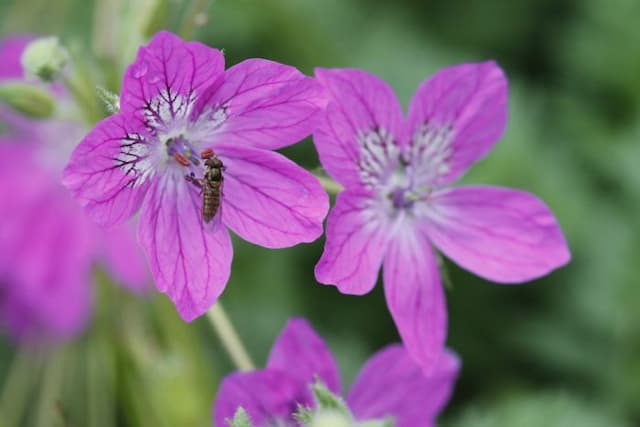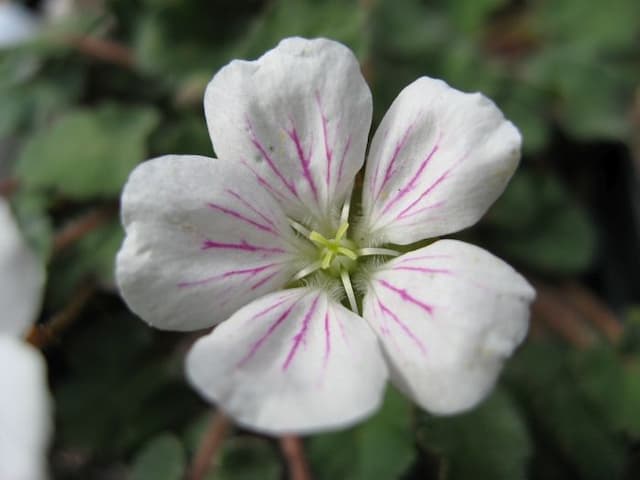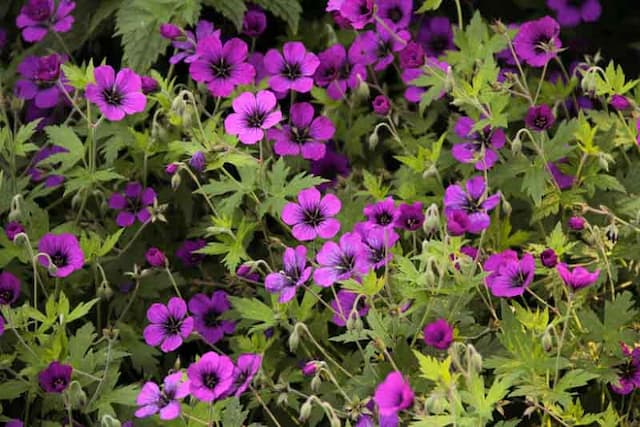Mourning Widow Geranium phaeum 'Our Pat'

ABOUT
'Our Pat' is a variety of cranesbill geranium known for its distinctive foliage and flowers. The leaves are deeply lobed and often have an attractive, dark mottling. Their intriguing patterning can vary from specks to marbling, predominantly in shades of green, sometimes with hints of darker colors. The blooms are a somber shade, usually a deep purple or maroon, with reflexed petals that enclose prominent stamens. These dark flowers often appear to float above the foliage, creating a moody yet graceful visual. The overall impression is one of a charming, cottage garden-style plant with a unique appeal, thanks to its unusual combination of leaf markings and flower color.
About this plant
 Names
NamesFamily
Geraniaceae
Synonyms
Dusky Cranesbill, Mourning Widow, Black Widow
Common names
Geranium phaeum 'Our Pat'.
 Toxicity
ToxicityTo humans
The common name for Geranium phaeum 'Our Pat' is dusky cranesbill. Generally, dusky cranesbill is considered non-toxic to humans. There are no known toxic effects from ingesting this plant, and it is not associated with symptoms of poisoning. However, as with any plant, individual allergies or sensitivities can occur, so it is still wise to avoid ingesting plant material that is not meant for consumption.
To pets
The common name for Geranium phaeum 'Our Pat' is dusky cranesbill. Dusky cranesbill is not typically toxic to pets. There is no evidence to suggest that ingestion of this plant by pets would lead to poisoning. However, it is always advisable to prevent pets from eating plants as a general precaution, and to watch for any signs of distress if any plant is ingested, since individual animals might have specific sensitivities.
 Characteristics
CharacteristicsLife cycle
Perennials
Foliage type
Deciduous
Color of leaves
Green
Flower color
Purple
Height
2 feet (60 cm)
Spread
2 feet (60 cm)
Plant type
Herb
Hardiness zones
5
Native area
Europe
Benefits
 General Benefits
General Benefits- Attracts Pollinators: Geranium phaeum 'Our Pat' is known to attract bees and other beneficial insects that are crucial for pollination.
- Drought Tolerant: Once established, it is relatively drought-tolerant, making it suitable for dryer gardens or regions.
- Low Maintenance: This plant requires minimal pruning and care, making it ideal for gardeners seeking low-maintenance plants.
- Shade Tolerant: It can thrive in partial to full shade, providing a flowering option for darker parts of the garden.
- Long Blooming: It has a long blooming period, often from late spring to early summer, adding prolonged color to the landscape.
- Ground Cover: With its dense foliage, it can act as ground cover, suppressing weeds and helping to stabilize the soil.
- Aesthetic Appeal: The deep purple flowers and attractive foliage provide aesthetic appeal and can be used in a variety of garden designs.
- Resistant to Pests: Geranium phaeum 'Our Pat' is generally resistant to pests, reducing the need for chemical interventions.
- Hardy: It is a hardy perennial that can withstand cold temperatures, making it suitable for many temperate climates.
- Non-Invasive: Unlike some other perennials, it tends not to be invasive, making it easier to control in a garden setting.
 Medical Properties
Medical PropertiesThis plant is not used for medical purposes.
 Air-purifying Qualities
Air-purifying QualitiesThis plant is not specifically known for air purifying qualities.
 Other Uses
Other Uses- Creating contrasting patterns in garden design: Geranium phaeum 'Our Pat' can bring a strong visual contrast in a garden with their dark flowers against lighter foliage plants.
- Attracting beneficial insects: The flowers can attract pollinators such as bees, which are important for the health of the garden ecosystem.
- Naturalizing in woodland areas: They are excellent for naturalizing in wooded or other natural areas due to their ability to spread and adapt to such environments.
- Companion planting: This geranium species can be utilized in companion planting to help deter certain pests from more vulnerable plants.
- Educational resource: The diverse growth habits and resilience of this plant make it an interesting case study in horticulture classes or educational programs on native and non-native species.
- Seasonal crafts: The distinct foliage and flowers can be used in seasonal crafts, such as pressed flower arrangements or wreaths.
- Photography: Enthusiasts may use 'Our Pat' as a subject for macro photography, capturing the intricate details of the blooms and leaves.
- Boundary delineation: When planted in rows or masses, they can serve as a soft, natural boundary in landscape design.
- Erosion control: Geranium phaeum's dense growth habit can help stabilize soil in areas prone to erosion.
- Garden themes: They can be used to create specific garden themes, such as "Victorian" or "cottage" gardens, due to their traditional appearance.
Interesting Facts
 Feng Shui
Feng ShuiThe plant Dusky Cranesbill is not used in Feng Shui practice.
 Zodiac Sign Compitability
Zodiac Sign CompitabilityThe plant Dusky Cranesbill is not used in astrology practice.
 Plant Symbolism
Plant Symbolism- True Friendship: Geraniums, in general, have been associated with true friendship, indicating a deep and meaningful connection between people.
- Unexpected Meeting: The unique appearance of Geranium phaeum 'Our Pat' might symbolize an unexpected encounter or a surprise meeting with someone.
- Comfort: Geraniums are often thought to convey comfort, especially in times of stress or sorrow, much like the presence of a good friend.
- Good Health: The robust nature of geraniums can represent wishes for good health and vitality.
 Water
WaterThe Dusky Cranesbill should be watered regularly, aiming for moist soil conditions without causing waterlogging. During the growing season, watering should be thorough, ensuring that the water reaches deep into the root zone; this might equate to about 1 inch of water per week, depending on climate and soil conditions. In hot and dry periods, increase watering frequency to maintain consistent moisture. However, in cooler months or during periods of rainfall, reduce watering to prevent soggy soil. Always allow the soil to dry out slightly between waterings to encourage healthy root growth.
 Light
LightThe Dusky Cranesbill thrives in partially shaded conditions where it receives filtered sunlight or morning sun. It can also adapt to full sun in cooler climates, but in hot areas, it should be protected from intense midday sun. The ideal spot for this plant would thus be an area with dappled shade or where it can enjoy the soft rays of the early day, protecting it from potential leaf scorch.
 Temperature
TemperatureThe Dusky Cranesbill performs best in a range of temperatures between 60°F and 75°F but can tolerate temperatures as low as 50°F and as high as 80°F. It is a hardy perennial that can survive winter colds in many climates, but prolonged exposure to temperatures below freezing can be damaging. Ideal growth occurs within the moderate temperature range outlined above.
 Pruning
PruningPruning the Dusky Cranesbill should occur to remove spent flowers and encourage a second bloom, as well as to maintain plant shape and health. Deadheading after the first flush of flowers can promote another round of blooms. Additionally, cutting back the plant in late summer or early fall can tidy up the garden and help prevent disease. The best time to perform major pruning is in late winter or early spring before new growth begins.
 Cleaning
CleaningAs needed
 Soil
SoilDusky Cranesbill thrives in well-draining soil enriched with organic matter, with a pH ranging from 5.8 to 6.5. A mix containing equal parts garden soil, compost, and peat or leaf mold is ideal to retain moisture yet allow excess water to drain, preventing root rot.
 Repotting
RepottingDusky Cranesbill should be repotted every 2-3 years to refresh the soil and allow space for growth. It's best to repot in the spring just before the active growing season starts.
 Humidity & Misting
Humidity & MistingDusky Cranesbill prefers moderate humidity levels and does well in typical outdoor humidity. They can tolerate some dry air but flourish when humidity is stable and not excessively low or high.
 Suitable locations
Suitable locationsIndoor
Place in medium light, ensure good air circulation.
Outdoor
Plant in partial shade; mulch to retain moisture.
Hardiness zone
4-8 USDA
 Life cycle
Life cycleGeranium phaeum, commonly known as Dusky Cranesbill, 'Our Pat', begins its life as a seed, which upon finding suitable moist and well-drained soil, germinates in early spring. As the seedling emerges, it develops into a rosette of foliage with lobed leaves, through which flower stalks will grow. Entering its flowering stage in late spring to early summer, 'Our Pat' produces small, nodding, dark purple-maroon flowers which are attractive to pollinators such as bees. After pollination, the petals fall away and the plant forms beak-like seed capsules, which when ripe, employ a mechanism to fling seeds away from the parent plant. During summer and autumn, Geranium phaeum 'Our Pat' continues to produce foliage and may flower sporadically. As a perennial, the plant will die back to the ground in late autumn or early winter and enter a period of dormancy before repeating the life cycle with the return of spring warmth.
 Propogation
PropogationPropogation time
Spring to early summer
Geranium phaeum 'Our Pat', commonly known as Dusky Cranesbill, can be propagated by division, which is the most popular method for this perennial plant. The optimal time to divide Geranium phaeum 'Our Pat' is in the spring or early fall when the plant is not in active bloom. To propagate by division, carefully lift the entire plant from the ground using a garden fork, making sure to keep as much of the root system intact as possible. Once removed, use a sharp knife or spade to divide the plant into smaller sections, each with a portion of the root system and several shoots. Replant the divisions immediately, ensuring they are planted at the same depth as they were originally growing, and water them thoroughly to minimize transplant shock. This method allows the gardener to produce new plants that are true to the parent plant and helps to rejuvenate older, overgrown clumps.









![Cranesbill [Rothbury Gem]](/_next/image?url=https%3A%2F%2Fplants-admin.emdemapps.com%2Fimages%2Fplants%2F%2Fimages%2F604b6243984c2.png&w=640&q=75)